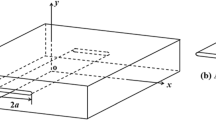Abstract
After briefly reviewing the features of an optical method for measuring boundary layer effects in cracked body problems, results of its application to two problem classes are presented. An interpretation of these results leads to a suggestion for accounting for boundary layer effects in design rationale.
Access this chapter
Tax calculation will be finalised at checkout
Purchases are for personal use only
Preview
Unable to display preview. Download preview PDF.
Similar content being viewed by others
References
Smith, C. W., “Use of Three Dimensional Photoelasticity and Progress in Related Areas”, Experimental Techniques in Fracture Mechanics 2, SESA Monograph No. 2, A. S. Kobayashi, Ed., Ch. 1, 1975, pp. 3–58.
Smith, C. W., “Use of Photoelasticity in Fracture Mech- anics”, Experimental Evaluation of Stress Concentration and Intensity Factors, Mechanics of Fracture, Vol. 7, G. C. Sih, Ed., Martinus-Nijhoff, Ch. 2, 1981, pp. 162–187.
Smith, C. W., “Use of Optical Methods in Stress Analysis of Three Dimensional Cracked Body Problems”, J. of Optical Engineering, Vol. 71, No. 4, 1982, pp. 696–703.
Sih, G. C., “A Review of the Three-Dimensional Stress Problem for a Cracked Plate”, Intl. J. of Fracture Mechanics, Vol. 7, No. 1, March 1971, pp. 39–61
Folias, E. S., “On the Three Dimensional Theory of Cracked Plates”, J. of Applied Mechanics, Vol. 42, Series E, No. 3, Sept. 1975, pp. 663–672.
Benthem, J. P., “On an Inversion Theorem for Conical Regions in Elasticity Theory”, J. of Elasticity, Vol. 9, No. 2, 1979, pp. 159–169.
Benthem, J. P., “The Quarter Infinite Crack in a Half Space: Alternative and Additional Solutions”, Intl. J. of Solids & Structures, Vol. 16, 1980, pp. 119–130.
Bazant, Z. P. and Estenssoro, L. F., “Stress Singularity and Propagation of Cracks at Their Intersection with Surfaces”, Northwestern Univ. Struct. Engr. Report No. 77-12/480, Dec. 1977.
Burton, W. S. and Sinclair, G. B., “On the 3D Implications of LEFM, An Intergral Equation Approach”, 16th National Symposium on Fracture Mechanics, Battelle-Columbus, August 1983.
Solecki, J. S. and Swedlow, J. L., “On the 3D Implications of LEFM - Finite Element Analysis of Straight and Curved Through Cracks in a Plate” (see Ref. 9).
Smith, C. W. and Epstein, J. S., “Measurements of Near Tip Fields Near the Right Angle Intersection of Straight Front Cracks” (In Press), Proc. of Tenth Canadian Fracture Conference, Waterloo, Canada, Aug. 1983.
Smith, C. W., Post, D. and Nicoletto, G., “Experimental Stress Intensity Distributions in Three Dimensional Cracked Body Problems”, Experimental Mechanics, Vol. 23, No. 4, Dec. pp. 378–382.
Nicoletto, G., Post, D. and Smith, C. W., “Moire Interfero- metry for High Sensitivity Measurements in Fracture Mechanics”, Proc. of 1982 joint SESA-JSME Conference on Experimental Mechanics, 1982, pp. 258–262.
Smith, C. W. and Epstein, J. S., “Measurement of Three Dimensional Effects in Cracked Bodies” (In Press), Proc. of Vth Intl. Congress on Experimental Stress Analysis, June 1984
Author information
Authors and Affiliations
Editor information
Editors and Affiliations
Rights and permissions
Copyright information
© 1985 Martinus Nijhoff Publisher, Dordrecht
About this paper
Cite this paper
Smith, C.W., Olaosebikan, O., Epstein, J.S. (1985). A Proposed Rationale for Accounting for Boundary Layer Effects in Designing Against Fracture in Three Dimensional Problems. In: Krausz, A.S. (eds) Time-Dependent Fracture. Springer, Dordrecht. https://doi.org/10.1007/978-94-009-5085-6_20
Download citation
DOI: https://doi.org/10.1007/978-94-009-5085-6_20
Publisher Name: Springer, Dordrecht
Print ISBN: 978-94-010-8748-3
Online ISBN: 978-94-009-5085-6
eBook Packages: Springer Book Archive




